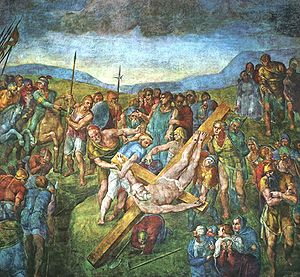The Crucifixion of St. Peter (Michelangelo)
| The Crucifixion of St. Peter | |
|---|---|
 |
|
| Artist | Michelangelo |
| Year | circa 1546–1550 |
| Type | Fresco |
| Dimensions | 625 cm × 662 cm (246 in × 261 in) |
| Location | Cappella Paolina, Vatican Palace, Vatican City |
The Crucifixion of St. Peter is a fresco painting by the Italian Renaissance master Michelangelo Buonarroti (c. 1546–1550). It is housed in the Cappella Paolina, Vatican Palace, in the Vatican City, Rome. It is the last fresco executed by Michelangelo.
The artist portrayed St. Peter in the moment in which he was raised by the Roman soldiers to the cross. Michelangelo concentrated the attention on the depiction of pain and suffering. The faces of the people present are clearly distressed. Pope Paul commissioned this fresco by Michelangelo in 1541 and unveiled it in his Cappella Paolina.
Restoration of the fresco completed in 2009 revealed an image believed to be a self-portrait of Michelangelo himself. The figure is standing in the upper left corner of the fresco, wearing a red tunic and a blue turban. Blue turbans were often worn by Renaissance sculptors to keep the dust out of their hair.
St. Peter is known by his many attributes, as “rock of the church,” the “first vicar of Christ,” or the first Pope. These attributes, specially the latter, made him the subject of many works of art in the Vatican. St Peter is depicted receiving the keys to the kingdom of Heaven from Christ on the wall of the Sistine chapel in Perugino’s The Delivery of the Keys. Pope Paul III commissioned Michelangelo to paint yet another fresco of St Peter around the year 1545. In contrast to themes of power and glory depicted by Perugino, Michelangelo elected to paint a much darker moment in the saint’s life. St Peter’s status as a major martyr is not only because he was the “first vicar of Christ,” but also because he was, like Christ, crucified. Although his final request is not mentioned in the canonical New Testament, it was popularly believed (due to the Apocryphal text known as the Acts of Peter) that he demanded: Crucify me head downwards, for I am not worthy to die as my master died. The Crucifixion fresco is situated on the eastern wall of the Pauline Chapel, which is significant because that is the location in which the cardinals have always held their elections for a new pope.
...
Wikipedia
